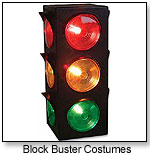 |

Tools:








Event Marketing Guru’s Corner: Green Means GoLearning to Read and Respond to Prospects’ Buying Signals
 Buying signals are all around us. We just have to learn to recognize them. They’re very much like a traffic light — red, yellow and green signals to stop, proceed with caution, or continue. Buying signals are all around us. We just have to learn to recognize them. They’re very much like a traffic light — red, yellow and green signals to stop, proceed with caution, or continue.
One of the biggest problems booth staffers encounter is missing their prospect’s buying signals. The solution resides in the following:
1. Listen carefully for verbal buying signals, such as terse questions that might feel like objections. Usually, this means the prospect is digging for more information and presenting a sales resistance wall. He or she is still standing there for a reason.
|
Exhibitors’ Tool Kit
1. Take copious notes. Understand your customer’s world. Take the time to get to know them. Help each one do an honest needs analysis.
2. Be flexible in your presentation. Resist, at all costs, the temptation to treat all customers the same.
3. Never overlook clear buying signals. Many sales cycles die here. If the customer is not ready to buy now, an extended presentation is self defeating.
4. Use summary statements to highlight areas in which you agree. Always let prospects know that you understand where they’re coming from. Establishing common ground is essential to consultative sales success.
5. Carefully detect the difference between buying signals and closing signals.
6. Watch carefully for nonverbal signals at all times. All too often, this language speaks much louder than words. |
2. Discover your prospect’s needs and business objectives by asking strategic probing questions. If you offer an instrument testing solution in the aviation industry, you might ask, “What sort of instrument testing solution are you currently utilizing? It would help me to know, and perhaps in knowing, I might be able to help you. Is that fair?”
Narrow your questions (talking 20 percent of the time and listening 80 percent of the time) to obtain increasingly specific information.
Eventually, you’ll get to, “Please, share with me some of the challenges you’re facing in regard to your current solution.” This is how you identify the current area of pain — “the problem.” Without knowing the problem, how can you position your offering as an optimal solution?
3. Guide the conversation with probing questions. Allow the prospect to feel in control of the buying cycle at all times.
4. Watch for nonverbal buying signals. The thumb and index finger massaging the chin of the prospect is always a certain nonverbal buying signal (yellow, more times than not).
5. Tune in to interpret the prospect’s signals. For instance, if a customer is leaning toward you and making strong eye contact, that is a probable green signal. Nodding the head or carefully reading your brochure are other examples. Another example of a green signal is when prospects ask “how to” questions. If you receive a green signal, a long sales pitch is unnecessary and may very well persuade the prospect to change his or her first generous impulse and cancel the sale.
Tone of voice almost always gives the red signal, as do folded arms or crossed legs. A serious expression followed by a few meaningful responses to your questions indicates a probable decision not to buy.
Yellow (“I’m on the fence”) signals are the easiest to detect. You must put yourself in the prospect’s shoes and slowly educate the prospect as to what truly makes your offering unique, significant and valuable from his or her standpoint.
6. Be cognizant to differentiate buying signals from closing signals. Another huge mistake that event marketers make is attempting to close too early before adequate value is established in the prospect’s mind.
 A buying signal says, “Continue to lay forth the reasons I should invest in this offering.” Keep building your case, as if the prospect were a jury, as to how you stack up versus the rest of the pack in your product/service category. A buying signal says, “Continue to lay forth the reasons I should invest in this offering.” Keep building your case, as if the prospect were a jury, as to how you stack up versus the rest of the pack in your product/service category.
A closing signal is a definitive implication that the prospect is ready to move forward with a final decision. This is always best facilitated through a series of minor either/or questions. Keep the decisions minor at this stage. People hate to make BIG decisions. If the offering is right for them, you’re role is not that of the seller. Rather, it is that of the assistant buyer — to ensure that you tailor your solution for the customer in the optimal manner, given his or her unique needs/objectives.
 Writer's Bio: Writer's Bio: Charles W. Allen is an independent consultant for professional event marketing solutions and specializes in sales training, motivational speaking and maximizing sponsorship sales. He also serves as executive director of the International Economic Alliance, which originated at Harvard University. Read more articles by this author
THIS BANNER IS AN AD:

• • • • • • • • • • • • • • • • • • • | • • • • • • • • • • • • • • • • • • |
Back to TDmonthly's front page
|  |
Advertise on TDmonthly

|

